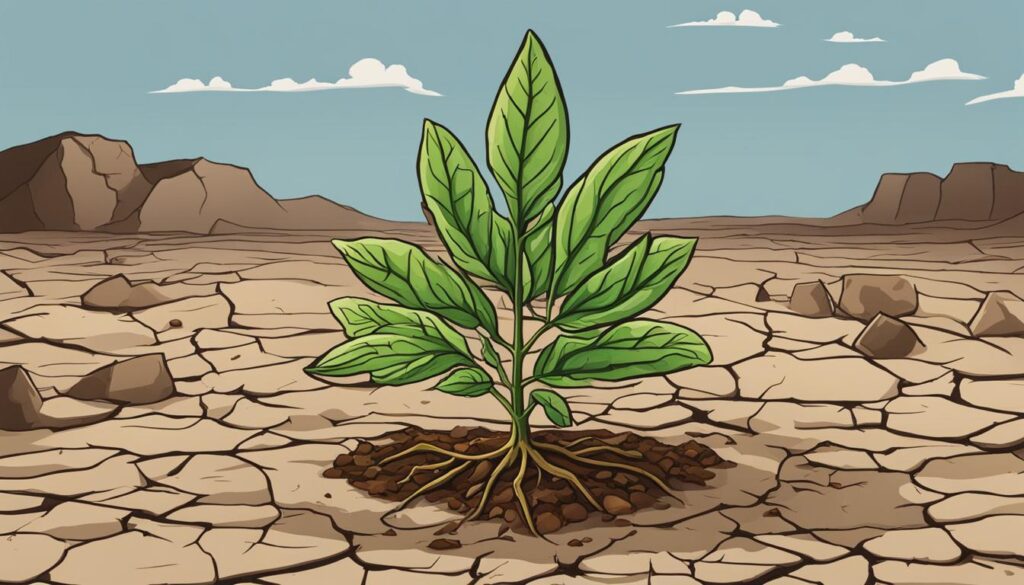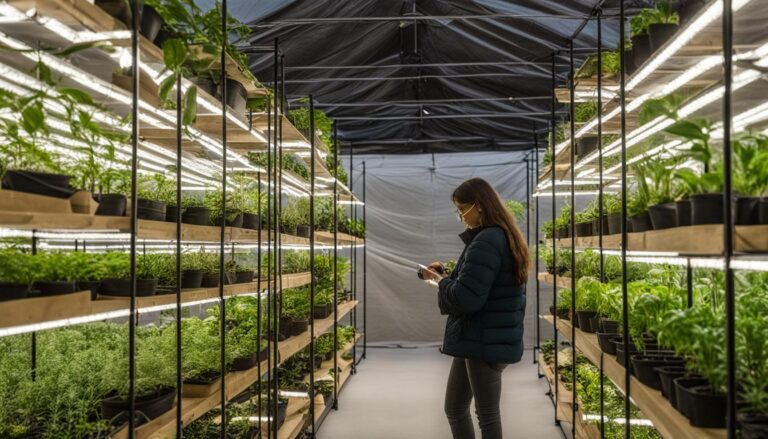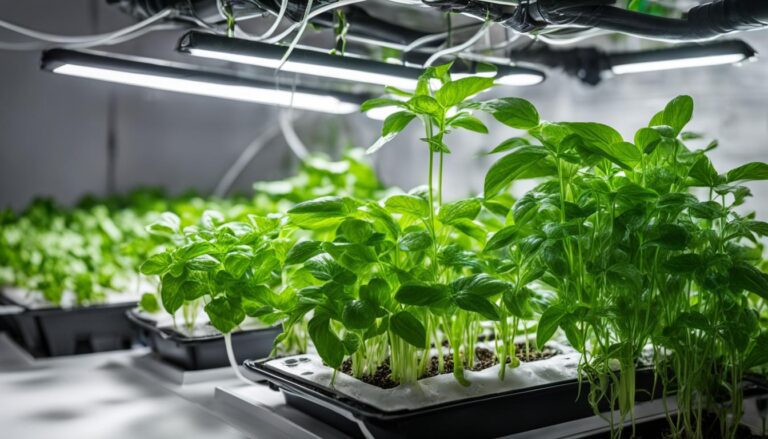
Medicinal plants play a valuable role in contributing to sustainability in various ways. They can be sustainably harvested, ensuring their availability for future generations.
Conservation efforts aimed at protecting medicinal plant species help maintain biodiversity and ecosystems.
By promoting the sustainable use of medicinal plants, we can support both health and environmental sustainability.
Key Takeaways:
- Medicinal plants can be sustainably harvested, ensuring their availability for the future.
- Conservation efforts help protect medicinal plant species and maintain biodiversity.
- Promoting the sustainable use of medicinal plants supports both health and environmental sustainability.
- Medicinal plants contribute to the preservation of ecosystems and the balance of biodiversity.
- Sustainable practices are essential to ensure the continued availability and benefits of medicinal plants.
The global value of medicinal plants
Medicinal plants have long been recognized for their global value in providing herbal products that contribute to human health and well-being. These plants have been used for centuries across various cultures and continue to play a significant role in traditional medicine practices.
The demand for herbal products derived from medicinal plants remains high, driven by the growing interest in natural remedies and alternative medicine.
However, the global availability of medicinal plants is under threat as they are disappearing at an alarming rate. Factors such as deforestation, habitat loss, overharvesting, and climate change contribute to the rapid decline in medicinal plant populations.
This poses a significant challenge to the sustainability of these valuable resources and their potential to contribute to healthcare and environmental well-being.
The loss of medicinal plants not only jeopardizes the availability of herbal products but also has broader implications for biodiversity conservation. Many medicinal plants species are integral to ecosystems, playing a crucial role in maintaining ecological balance and supporting other plant and animal species.
The disappearance of these plants can have cascading effects on entire ecosystems, leading to a loss of biodiversity and ecological resilience.
In order to address the escalating threat to medicinal plants, it is essential to raise awareness about their global value and the need for conservation efforts.
Sustainable harvesting practices, habitat restoration, and the establishment of protected areas are some of the strategies that can help mitigate the risks faced by medicinal plants.
Promoting the cultivation of endangered medicinal plant species in botanical gardens and encouraging sustainable trade practices can contribute to their conservation and long-term availability.
Top 5 Medicinal Plants in Global Demand
| Plant Name | Common Uses | Region of Origin |
|---|---|---|
| Ginseng | Boosts energy, improves cognitive function | Asia |
| Turmeric | Anti-inflammatory, antioxidant properties | South Asia |
| Echinacea | Enhances immune system, treats colds | North America |
| St. John’s Wort | Treats depression, anxiety | Europe |
| Aloe Vera | Heals wounds, soothes skin irritations | Arabian Peninsula |
Conservation and Sustainable Use Strategies for Medicinal Plants
Conserving medicinal plants and ensuring their sustainable use is crucial for maintaining their availability and preserving biodiversity. Various strategies and methodologies have been proposed to achieve these goals.
In Situ Conservation
In situ conservation involves protecting medicinal plant species in their natural habitats. This approach focuses on maintaining the integrity of ecosystems and habitats where these plants naturally occur.
Protected areas, such as national parks and reserves, play a vital role in in situ conservation efforts. By preserving these areas, we can safeguard the habitats of medicinal plants and prevent their degradation.
Ex Situ Conservation
Ex situ conservation methods involve preserving medicinal plant species outside their natural habitats. This can be achieved through the establishment of botanical gardens, seed banks, and living collections.
These facilities allow for the cultivation and propagation of medicinal plants, ensuring their availability for future research, cultivation, and reintroduction into the wild if necessary.
Cultivation Practices
Cultivation practices play a significant role in the sustainable use of medicinal plants. By cultivating these plants in controlled environments, the pressure on wild populations can be reduced.
Sustainable cultivation techniques, such as agroforestry and mixed cropping, can also enhance biodiversity and provide economic opportunities for local communities.
| Conservation Strategies | Sustainable Use Solutions | Biotechnical Approaches |
|---|---|---|
| In situ conservation | Sustainable cultivation techniques | Tissue culture |
| Ex situ conservation | Agroforestry and mixed cropping | Molecular marker-based approaches |
| Protecting natural habitats | Harvesting guidelines and regulations | Genetic engineering |
Biotechnical approaches, such as tissue culture and molecular marker-based approaches, have shown promise in enhancing the productivity and quality of medicinal plants.
Tissue culture techniques allow for the mass production of plants under controlled conditions, while molecular marker-based approaches facilitate the identification and selection of high-yielding and genetically diverse plant varieties.
Genetic engineering techniques offer the potential to improve the traits and properties of medicinal plants, further contributing to their sustainable use.
By implementing a combination of these conservation strategies, sustainable use solutions, and biotechnical approaches, we can ensure the long-term availability of medicinal plants while promoting their ecological and socioeconomic benefits.
Threats to Medicinal Plant Resources
Medicinal plant resources face numerous threats that jeopardize their existence and long-term sustainability. Overharvesting is a significant concern, driven by the high demand for medicinal plants and their derivatives.
This unregulated and unsustainable collection of plants can lead to the depletion of wild populations, pushing them towards the brink of extinction. As a result, the loss of these plants not only affects their medicinal value but also disrupts ecosystems and biodiversity.
Habitat destruction is another critical threat to medicinal plant resources. The destruction of natural habitats, such as rainforests and other ecosystems, eliminates the essential environments where these plants thrive.
Deforestation, urbanization, and agricultural expansion contribute to the loss of habitat, further exacerbating the decline of medicinal plant populations. This destruction disrupts the delicate balance of ecosystems, impacting the biodiversity and overall health of our planet.
The combination of overharvesting and habitat destruction poses a severe risk to the availability and sustainability of medicinal plant resources.
Without proper conservation measures and sustainable practices, many plant species may face extinction, potentially leading to the loss of valuable medicinal properties and ecological benefits they provide.
It is crucial to address these threats through proactive conservation efforts, promoting responsible harvesting practices, and preserving the unique habitats that support these plants.

Examples of Threatened Medicinal Plant Species
| Plant Species | Status | Main Threats |
|---|---|---|
| Echinacea angustifolia | Endangered | Overharvesting, habitat loss |
| Ginseng (Panax spp.) | Threatened | Overharvesting, habitat destruction |
| Sandalwood (Santalum album) | Critical | Illegal harvesting, habitat fragmentation |
| Golden Seal (Hydrastis canadensis) | Vulnerable | Overharvesting, loss of suitable habitat |
The importance of medicinal plants in traditional medicine
Traditional medicine has long relied on the use of medicinal plants to address various health concerns. In many developing countries, medicinal plants play a crucial role in primary healthcare, providing accessible and affordable treatment options for a significant portion of the population.
Herbal drugs derived from medicinal plants are used to alleviate symptoms, promote healing, and support overall well-being.
Medicinal plants offer a vast array of natural compounds that have been recognized for their therapeutic properties and health benefits.
These plants have been used for centuries in traditional healing practices, and their efficacy is supported by a wealth of traditional knowledge and empirical evidence.
The use of medicinal plants in traditional medicine continues to be relevant and valued, providing an alternative or complementary approach to conventional healthcare.
The utilization of medicinal plants in traditional medicine extends beyond developing countries. In many developed nations, traditional medicine practices have gained recognition and popularity, leading to the incorporation of herbal drugs into conventional healthcare systems.
Many prescribed medicines in these countries are derived from medicinal plant species, showcasing the continued importance and relevance of traditional medicine in modern society.
| Benefit | Example |
|---|---|
| Relief from digestive issues | Peppermint for soothing an upset stomach |
| Pain management | Willow bark for natural pain relief |
| Immune support | Echinacea for boosting the immune system |
Furthermore, the use of medicinal plants in traditional medicine highlights the significance of a holistic approach to healthcare.
Traditional medicine recognizes the interconnectedness of the body, mind, and spirit, and the importance of addressing underlying causes of health issues rather than solely focusing on symptom management.
By incorporating medicinal plants into treatment protocols, traditional medicine aims to restore balance and promote overall wellness.
As we navigate the future of healthcare and sustainability, it is crucial to recognize and appreciate the role of medicinal plants in traditional medicine.
By preserving traditional knowledge, supporting research on herbal medicines, and promoting the sustainable cultivation and harvest of medicinal plants, we can ensure the continued availability and benefits of these valuable natural resources.
Medicinal Plants in the Pharmaceutical Industry
Medicinal plants play a crucial role in the pharmaceutical industry, contributing to the discovery and development of new drugs and natural health products. The rich chemical diversity found in these plants offers a vast array of potential therapeutic compounds, making them valuable resources for drug research.
Pharmaceutical companies extensively study medicinal plants to isolate and identify bioactive compounds that could be used to treat various diseases and health conditions.
These compounds are then subjected to rigorous testing and clinical trials to evaluate their safety and efficacy. Successful compounds can be further developed into prescription drugs or incorporated into natural health products.
The utilization of medicinal plants in the pharmaceutical industry has led to significant advancements in drug discovery. Many well-known drugs have their origins in plant sources.
For example, aspirin is derived from willow bark, while the anti-malarial drug artemisinin is extracted from the Artemisia annua plant. These examples highlight the potential of medicinal plants in providing effective treatments for a wide range of ailments.
The Role of Medicinal Plants in Drug Research
In drug research, medicinal plants are often utilized as a starting point for discovering new compounds and potential drug candidates. Scientists examine the chemical compositions of different plant species, identifying bioactive compounds with therapeutic properties.
By understanding the mechanisms of action and pharmacological properties of these compounds, researchers can develop targeted drugs for specific health conditions.
Furthermore, medicinal plants offer a sustainable source of potential drug compounds. Unlike synthetic drugs, which often require extensive chemical synthesis, plant-derived compounds can be obtained through extraction methods that are less impactful on the environment.
This aligns with the growing demand for sustainable and eco-friendly practices in the pharmaceutical industry.
In conclusion, medicinal plants hold immense potential for the pharmaceutical industry. Their chemical diversity and therapeutic properties provide a valuable source for drug discovery and the development of natural health products.
By continuing to explore and harness the power of medicinal plants, researchers can contribute to advancements in healthcare and improve the quality of life for people around the world.
The Need for Sustainable Practices in Medicinal Plant Use
Sustainable practices in the use of medicinal plants are crucial for promoting environmental sustainability and preserving these valuable resources for future generations.
By adopting sustainable harvesting techniques and implementing resource management strategies, we can minimize the negative impact on plant populations and ecosystems.
Furthermore, promoting sustainable development in the utilization of medicinal plants ensures their continued availability and supports the overall goal of sustainability.
The environmental impact of medicinal plant use is a significant concern. Overharvesting and habitat destruction pose threats to the survival of many medicinal plant species.
These practices not only deplete plant populations but also disrupt the delicate balance of ecosystems. By implementing sustainable practices, such as selective harvesting and cultivation, we can mitigate these negative effects and protect the ecological integrity of medicinal plant habitats.
The Importance of Sustainable Practices
- Promotes the conservation of medicinal plant species and biodiversity
- Preserves the natural habitats and ecosystems that support medicinal plants
- Ensures the availability of medicinal plants for future generations
- Limits the environmental impact of plant collection and resource extraction
- Supports sustainable development and the integration of traditional medicine with modern healthcare
By prioritizing sustainable practices in the use of medicinal plants, we can strike a balance between meeting current healthcare needs and preserving these valuable resources for the future.
Conservation efforts, sustainable harvesting techniques, and the integration of traditional medicine into modern healthcare systems all contribute to the long-term viability of medicinal plants and the promotion of sustainable development.

| Environmental Impact | Sustainable Practices |
|---|---|
| Overharvesting | Selective harvesting and cultivation |
| Habitat destruction | Conservation of natural habitats and ecosystems |
| Disruption of ecosystems | Promotion of ecological balance through sustainable practices |
| Threat to biodiversity | Conservation of medicinal plant species and overall biodiversity |
The Role of Medicinal Plants in Biodiversity Conservation
Medicinal plants not only have significant value in traditional medicine and the pharmaceutical industry but also play a crucial role in biodiversity conservation. The preservation of medicinal plant species contributes to the preservation of ecosystems and the overall balance of biodiversity.
By protecting and conserving medicinal plant species, we can ensure the continued existence of unique and diverse plant populations. These plants provide habitats and food sources for various organisms, including insects, birds, and mammals.
The conservation of medicinal plants, therefore, indirectly supports the survival and well-being of numerous other species in their ecosystems.
Furthermore, the loss of medicinal plant species due to plant species extinction can have far-reaching consequences. Overexploitation, habitat destruction, and climate change are some of the factors that contribute to the decline of medicinal plant populations.
If these plants disappear, we not only lose potential sources of new drugs and therapeutic compounds but also disrupt the delicate ecological balance.
The Importance of Medicinal Plants in Ecosystem Preservation
Beyond their value in traditional medicine and pharmaceuticals, medicinal plants play a vital role in ecosystem preservation. They contribute to the stability and resilience of ecosystems by maintaining biodiversity and supporting ecological interactions.
Medicinal plants provide essential services such as soil erosion control, water purification, and nutrient cycling. They also contribute to the pollination of flowering plants and the dispersal of seeds, ensuring the reproduction and survival of many plant species.
Preserving medicinal plant species helps protect the intricate web of life within ecosystems and promotes ecological balance. It is crucial to recognize the significant role of these plants in biodiversity conservation and take necessary measures to conserve and sustainably manage their populations.
| Benefits of Medicinal Plants in Biodiversity Conservation | Examples |
|---|---|
| 1. Habitat preservation | Protecting medicinal plants ensures the preservation of their habitats, which are home to a wide range of species. |
| 2. Biodiversity maintenance | Medicinal plants contribute to the maintenance of biodiversity by providing food and shelter for various organisms. |
| 3. Ecosystem resilience | The conservation of medicinal plants enhances the overall resilience and stability of ecosystems, making them more capable of withstanding environmental changes. |
| 4. Ecological interactions | Medicinal plants support important ecological interactions such as pollination and seed dispersal, ensuring the survival of other plant species. |
Preserving and conserving medicinal plant species is not only critical for the future of medicine but also for the health and well-being of our planet. It is paramount that we recognize the importance of these plants in biodiversity conservation and implement measures to protect them for future generations.

The future of medicinal plants and sustainability
The future of medicinal plants and their contribution to sustainability is deeply intertwined with the adoption of sustainable development practices and the preservation of these valuable resources. As we move forward, it is crucial to recognize the importance of medicinal plants in maintaining both human and environmental well-being.
To ensure the long-term viability of medicinal plants, preserving their habitats and implementing conservation measures is essential. This includes protecting natural ecosystems where these plants grow and promoting sustainable harvesting techniques. By doing so, we can maintain the delicate balance of biodiversity and ecosystem services that medicinal plants provide.
The concept of sustainable development plays a key role in securing the future of medicinal plants. Sustainable practices aim to meet the needs of the present generation without compromising the ability of future generations to meet their own needs.
In the context of medicinal plants, this involves responsibly managing their collection, cultivation, and utilization to ensure their continued availability and benefits for the future.
By recognizing the value of medicinal plants and their potential to contribute to sustainability, we can prioritize their conservation and promote sustainable practices.
Research and innovation in the field can help identify new ways to harness the therapeutic properties of medicinal plants while minimizing their environmental impact. Together, we can shape a future where medicinal plants thrive, supporting both human health and the well-being of our planet.
FAQ
How do medicinal plants contribute to sustainability?
Medicinal plants contribute to sustainability by being sustainably harvested, ensuring their availability for future generations. Conservation efforts aimed at protecting medicinal plant species help maintain biodiversity and ecosystems. By promoting the sustainable use of medicinal plants, we can support both health and environmental sustainability.
What is the global value of medicinal plants?
Medicinal plants are highly valuable sources of herbal products on a global scale. They have been used for centuries and continue to be in high demand. However, these plants are disappearing at an alarming rate, which poses a threat to their availability and their contribution to sustainability.
What are the conservation and sustainable use strategies for medicinal plants?
Various strategies and methodologies have been proposed for the conservation and sustainable use of medicinal plants. These include both in situ and ex situ conservation methods, cultivation practices, and resource management techniques. Biotechnological approaches, such as tissue culture and molecular marker-based approaches, can also be employed to improve the yield and potency of medicinal plants.
What are the threats to medicinal plant resources?
Medicinal plant resources face several threats that can contribute to their extinction. Overharvesting and habitat destruction are significant factors affecting the availability of medicinal plants. The increasing human population and plant consumption have led to the near exhaustion of many medicinal plant species. It is crucial to address these threats to ensure the sustainability of medicinal plants.
What is the importance of medicinal plants in traditional medicine?
Medicinal plants have immense importance in traditional medicine practices worldwide. In many developing countries, a substantial percentage of the population relies on herbal drugs for their primary healthcare needs. Additionally, traditional medicine contributes to the use of medicinal plants in developed countries, with a significant portion of prescribed medicines derived from plant species.
How do medicinal plants contribute to the pharmaceutical industry?
Medicinal plants have played a vital role in the pharmaceutical industry, with many drugs derived from plant sources. The discovery of new drugs and the development of natural health products rely on the study and utilization of medicinal plants. These plants offer a vast array of chemical compounds that can be further explored for their therapeutic properties.
Why is sustainable practice important in the use of medicinal plants?
Promoting sustainable practices in the use of medicinal plants is essential for long-term sustainability. Sustainable harvesting techniques and resource management can minimize the environmental impact of plant collection. By adopting sustainable practices, we can ensure the availability and continued use of medicinal plants for generations to come.
What is the role of medicinal plants in biodiversity conservation?
Medicinal plants play a crucial role in biodiversity conservation. Protecting and conserving medicinal plant species helps maintain the balance and diversity of ecosystems. Many medicinal plant species are threatened with extinction, highlighting the need for conservation efforts to preserve their vital contribution to biodiversity.
What does the future hold for medicinal plants and sustainability?
The future of medicinal plants and their contribution to sustainability depends on the implementation of conservation measures and sustainable practices. Preserving medicinal plants and their habitats is crucial for their long-term viability. By recognizing their value and promoting sustainable development, we can ensure the continued availability and benefits of medicinal plants.







One Comment
Comments are closed.